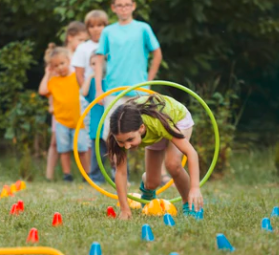Living an active lifestyle does not have to feel like a chore. When movement is paired with fun, it turns into a source of joy rather than an obligation. Games have always had the power to bring people together, spark laughter, and create memories. What makes them even more special is their ability to encourage activity in a natural way. Instead of forcing ourselves into routines that may feel dull, games show us that staying active can be exciting, creative, and rewarding.
The Magic of Playful Movement
One of the most powerful aspects of games is how they shift our mindset. Instead of focusing on burning calories or sticking to a strict workout, the emphasis turns to enjoying the moment. Running in a game of tag, tossing a ball, or jumping around in a dance challenge does not feel like exercise, yet it keeps the body moving. This joyful approach to activity can help both children and adults build habits that support health without the pressure of formal training.
When activity feels playful, the mind releases stress, and energy levels rise naturally. Movement no longer becomes something we dread, but something we look forward to. This shift is the foundation of active living—finding joy in motion and seeing it as a celebration of what the body can do.
Games That Bring Families Together
Families often struggle to balance busy schedules, and physical activity may fall to the side. Fun games offer an easy solution by combining quality time with movement. Classic backyard games like hide-and-seek, kickball, or jump rope bring parents and children together in ways that screens cannot. The laughter shared during these moments strengthens bonds while promoting activity for everyone involved.
For younger children, playful games like animal charades, where everyone acts out a creature in motion, not only encourage imagination but also keep little bodies moving. Parents benefit too, since these activities involve bending, stretching, and even bursts of cardio disguised as play.
Team Spirit and Energy
Games that require teamwork, such as relay races or scavenger hunts, do more than get the heart pumping. They build cooperation, communication, and problem-solving skills. The excitement of working with others brings a sense of achievement that goes beyond physical health. Winning or losing becomes less important than the shared effort and energy poured into the activity.
For workplaces, lighthearted games during breaks can uplift team spirit. Something as simple as tossing a ball around while sharing ideas or having a quick office “step challenge” can bring new energy into the day. These small playful breaks remind adults that movement can be refreshing, not just demanding.
Creative Ways to Stay Active Through Play
The beauty of playful games lies in their adaptability. They can be as simple as jumping over chalk lines drawn on the sidewalk or as organized as community dance competitions. Creativity keeps the excitement alive.
One enjoyable option is to turn chores into games. For instance, families can set a timer to see who finishes tidying up the fastest, turning what might feel like a task into a playful challenge. Another creative approach is using music. Dance-based games that combine rhythm and movement encourage flexibility, stamina, and coordination while filling the air with joy.
Technology also brings new opportunities. Interactive games that track motion through sensors or mobile devices allow people to turn their living rooms into playful spaces. These digital tools may not replace outdoor fun, but they add variety and can keep motivation high.
Teaching the Value of Lifelong Activity
The impact of fun games goes far beyond the moment. When children learn to associate joy with movement, they carry that attitude into adulthood. A child who remembers laughter from running around in a game of tag is more likely to see running as enjoyable later in life. Adults who rediscover playful activities often realize that fitness does not have to be limited to gyms or schedules.
This playful spirit teaches resilience. On days when life feels heavy, playful movement can lift the mood and ease tension. The habit of turning to games for refreshment ensures that activity is not only about health but also about emotional balance and social connection.
Building Confidence Through Play
Another hidden benefit of active games is the confidence they inspire. When people master a new game, learn a new dance, or complete a playful challenge, they feel capable. That sense of success builds a positive relationship with activity. Instead of comparing themselves to fitness standards, individuals celebrate personal victories.
Children especially thrive when they feel included in group games, as it gives them a sense of belonging and self-worth. Adults, too, gain confidence when they realize that play is not reserved for youth. Laughter shared over a playful activity creates lasting memories while strengthening self-belief.
Turning Everyday Life Into Play
Active living becomes sustainable when games are woven into daily routines. Walking the dog can turn into a playful race. Waiting at the bus stop can become a chance to balance on the curb or create silly step patterns. Even cooking can turn into a playful moment when paired with music and dance.
The key is to see play not as a separate event but as an attitude. Active living does not demand hours of free time. It thrives in small, joyful moments sprinkled throughout the day.
The Joyful Lesson of Playful Games
Games remind us that activity is not a burden—it is a gift. Through fun, we reconnect with the natural joy of movement. Whether through laughter with family, teamwork at school or work, or creative challenges alone, playful activity teaches us to see living actively as a celebration.
When we choose games, we choose joy. We choose energy. We choose to live in a way that uplifts both body and spirit. That is the true power of fun games—they do not just encourage movement, they teach the joy of active living.














